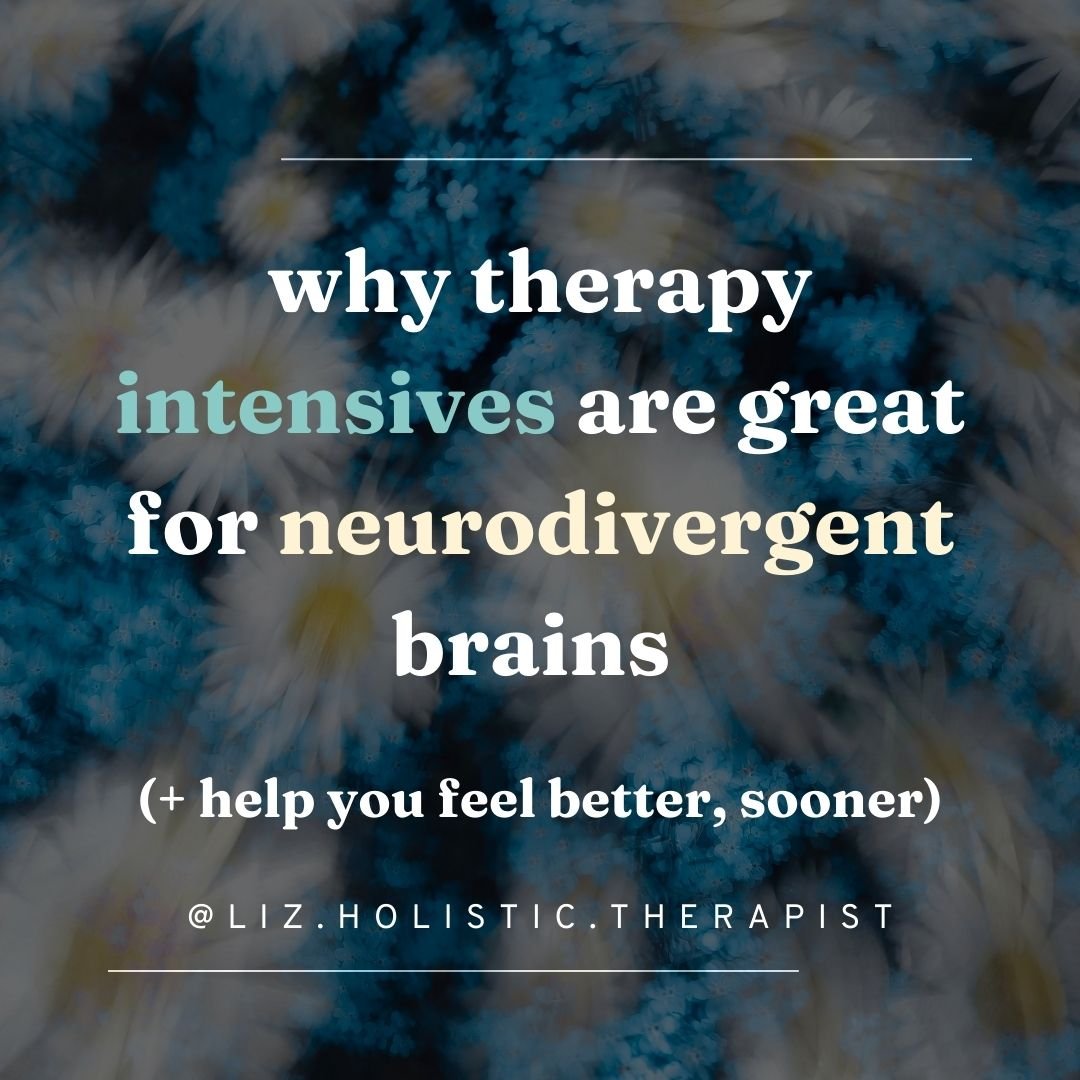Liz Zhou
Holistic Trauma Therapist, Coach, Speaker
Helping highly sensitive, neurodivergent adults & couples.
BLOG
EMDR vs. Brainspotting: Which is Better for Neurodivergent Brains?
EMDR and Brainspotting offer unique approaches to brain-body healing. Discover which therapy might be a better fit for you based on factors like structure, flexibility, and session frequency (weekly vs. intensive).
Why Therapy Intensives are Great for Neurodivergent Brains
If you’re neurodivergent (autistic, ADHD, highly sensitive) and traditional therapy hasn’t quite worked for you, a therapy intensive could be a helpful alternative. Intensives are a form of short-term, accelerated therapy, using powerful modalities like Internal Family Systems, Brainspotting, and EMDR to heal the nervous system.
What is Decolonizing Therapy? | 3 Compassionate Ways to Decolonize Our Minds
Decolonizing the mind is an ongoing process that requires our active curiosity and participation. When we challenge colonial thinking, we can work toward dismantling systems of oppression and building a world that is truly inclusive and safe for all.
Healing Complex Trauma as a Neurodivergent Person
Let’s explore the 4 phases of CPTSD recovery. Here’s why you might feel worse before you feel better, and why you might feel more neurodivergent (more autistic, more ADHD) as you heal from complex trauma.
What’s the Calm Place Practice? | Resourcing in EMDR Therapy
Before you ever process a distressing memory through EMDR, you’ll first build your toolkit of resources. One essential tool is the Calm Place practice, designed to soothe and stabilize your nervous system. In this blog post, we’ll share creative examples of calm places and offer guidance for those who struggle with visualization.
How Does Bilateral Stimulation Work? | Why EMDR Therapy is Not Just Eye Movements
EMDR accesses the parts of the brain where traumatic memories are stored and changes the neural wiring around those memories — through a simple technique called bilateral stimulation (BLS). Learn what BLS looks like in an EMDR session, and why it works so well for trauma reprocessing.
What’s Positive States Practice? | Neuroplasticity & Resourcing in EMDR Therapy
Positive States Practice is not about bypassing difficult emotions. It’s about nurturing the positive pathways that are already there, so that you can navigate difficult experiences in a more resourced way. Let’s explore what this practice looks like, and how it can enhance outcomes in EMDR trauma therapy.
EMDR Therapy for Autistic Adults | A Neurodiversity-Affirming Perspective
Is EMDR therapy for autistic people different than EMDR for non-autistics? The answer is more complicated than you might think. An autistic therapist shares how neurotypes influence the way that we process trauma — and why EMDR can be a great fit for neurodivergent brains.
Complex Trauma Recovery: The Benefits of IFS and EMDR Therapy
How do you go from realizing you have complex trauma to actually healing from it? Learn how trauma-focused modalities like Internal Family Systems and Eye Movement Desensitization & Reprocessing can help you get to the other side of complex trauma — toward more fulfilling relationships & connection with your authentic Self.
What’s the Inner Ally Practice? | Resourcing in EMDR Therapy
Resourcing is the initial phase of the EMDR therapy protocol, designed to stabilize your nervous system and create a sense of calm and steadiness within yourself. Let’s delve into the Inner Ally practice — what it is, why it works, and how to create your own Nurturing, Protective, Playful, and Wise Figures.
Trauma Therapy Intensives (EMDR + IFS) in Denver, Colorado
Therapy intensives are a short-term, accelerated, and highly efficient treatment. If you’re tired of weekly therapy (or can’t fit it into your busy schedule in the first place), explore an intensive approach to healing in Denver, or online across Colorado.
How to Reduce Driving Anxiety: A Holistic Guide for Highly Sensitive People
Do you avoid driving, or feel overwhelmed by the thought of it? Explore HSP-friendly strategies to make driving more tolerable (and even enjoyable).
What’s the Container in EMDR Therapy? (FAQs + Examples)
Learn about the “container practice” in EMDR therapy – a way to safely store difficult thoughts and feelings until you’re ready to process them with your therapist. This blog post will answer all your questions about the container: how to create it, what to put in it, and why it’s different (and healthier) than bottling up emotions forever.
What Your Bones Know: How to Heal Complex Trauma and CPTSD
Healing is a journey, not a destination, and it involves weaving together different threads of support. Through the power of relationships, play, community, and therapy, it’s possible to heal complex trauma (CPTSD).
What is Neurodiversity-Affirming EMDR Therapy?
Feeling lost in a world designed for neurotypical brains? Learn how EMDR therapy can be adapted to your unique needs, preferences, and neurotype.
EMDR Intensives vs. Weekly Therapy: What’s the Difference?
EMDR therapy can be a powerful tool for healing, but is weekly therapy the only way? Discover EMDR intensives, an intensive program designed to achieve results in a shorter timeframe.
Does EMDR Create False Memories? (Addressing 5 Myths about EMDR Therapy)
EMDR therapy is gaining traction as a trauma healing modality, but misconceptions linger. Does EMDR create false memories? Is it the same as hypnosis? Let’s discuss the myths & truths about EMDR therapy.
How to Prepare for Psychedelic Therapy: Set & Setting
Learn how to create the ideal internal and external environment for a safe and meaningful psychedelic journey.
What is Psychedelic Integration Therapy? (and How to Choose a Therapist)
Curious about the healing potential of psychedelics, but unsure what happens after the journey? Whether you’re processing an experience with ketamine, psilocybin, or ayahuasca, here’s how psychedelic integration therapy might support you.
4 Myths about Trauma Therapy (and What to Know Instead)
You know the therapy scenes you see in movies — lying on a couch, crying for an hour? That’s not everyone’s experience. Let’s shed light on what trauma therapy is actually about.




















